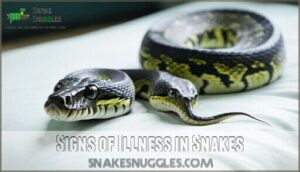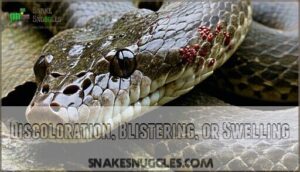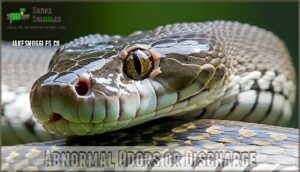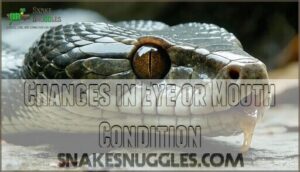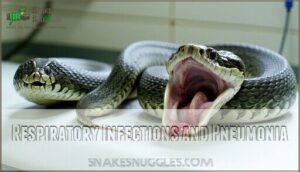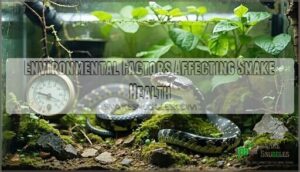This site is supported by our readers. We may earn a commission, at no cost to you, if you purchase through links.
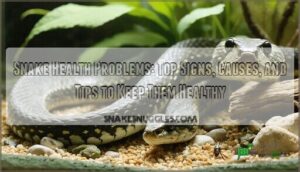 Snake health problems can sneak up on you faster than you’d think.
Snake health problems can sneak up on you faster than you’d think.
You’ll spot trouble through changes in appetite, unusual lethargy, or odd resting positions.
Physical red flags include loose scales, strange odors, mouth rot, and respiratory issues like wheezing.
Common culprits are mites, internal parasites, bacterial infections, and improper humidity levels.
Your snake’s environment plays a huge role – think of it as their entire world in a box.
Temperature swings and poor ventilation create perfect storm conditions for illness.
Watch for defensive behavior changes too, since sick snakes often act differently.
Catching these warning signs early makes all the difference in treatment success.
The snake’s health is heavily influenced by its surroundings, making proper humidity levels and a well-maintained environment crucial.
By being aware of these factors, you can help prevent health issues and ensure your snake stays healthy.
Table Of Contents
- Key Takeaways
- Signs of Illness in Snakes
- Physical Signs of Snake Illness
- Common Health Issues in Snakes
- Recognizing Respiratory Problems in Snakes
- Behavioral Changes Indicating Snake Illness
- Environmental Factors Affecting Snake Health
- Preventive Measures for Snake Health
- Seeking Veterinary Care for Your Snake
- Maintaining Your Snake’s Health
- Frequently Asked Questions (FAQs)
- How can I tell if my snake is sick?
- What are some specific symptoms of common illnesses in snakes?
- Why is shedding a concern for snake health?
- What are some signs of respiratory problems in snakes?
- What are some behavioral changes that may indicate snake illness?
- When should I seek veterinary care for my snake?
- What is the most common cause of death in snakes?
- What does an unhealthy snake look like?
- What neurological diseases do snakes get?
- What are the signs of illness in snakes?
- Conclusion
Key Takeaways
- Watch for early warning signs – You’ll catch problems faster by monitoring appetite changes, breathing difficulties, unusual lethargy, and behavioral shifts like increased aggression or strange posturing.
- Environmental factors make or break health – You must maintain proper temperature gradients, humidity levels (50-70%), and ventilation to prevent respiratory infections and scale rot that can quickly become serious.
- Physical symptoms need immediate attention – Don’t ignore loose scales, mouth rot, unusual odors, skin lesions, or wheezing sounds, as these often indicate bacterial infections, parasites, or other treatable conditions.
- Prevention trumps treatment every time – You’ll save money and stress by establishing proper enclosure setup, regular vet checkups, balanced feeding schedules, and consistent environmental monitoring rather than waiting for emergencies.
Signs of Illness in Snakes
Spotting signs of illness in your snake can be tricky since they’re experts at hiding them.
Keep an eye on changes in appetite, activity, shedding, or behavior—these could mean it’s time to call the vet.
Changes in Appetite or Feeding Habits
Is your snake’s appetite different lately? Changes in feeding habits can hint at health issues.
Watch for these signs:
- Refusal to feed – skipping meals without explanation.
- Regurgitation causes – spitting food out after eating.
- Persistent hunger – showing excessive interest in food.
- Snake anorexia – complete loss of appetite.
- Prey size issues – struggling to swallow or digest meals.
These could indicate stress, poor husbandry, or underlying illness. Recognizing lethargy and weakness can also be essential for early detection.
Even obesity signs, like visible fat rolls, can result from overfeeding. Keep an eye on their snake diet and feeding routine. Consult a vet if your snake’s diet isn’t normal.
Altered Activity Levels or Lethargy
Notice your snake snoozing more than usual? That could point to snake illness.
Causes of lethargy include dehydration, stress, or even underlying diseases.
Recognizing lethargy is key—watch for signs like reduced activity levels, weight loss, or appetite changes.
The severity of lethargy often depends on its duration.
Don’t wait—explore treatment options with a vet to guarantee your snake’s health.
Unusual Posturing or Resting Positions
When your snake exhibits strange posture, like head tilting, neck stretching, or difficulty coiling, it’s sending you signals about potential issues.
These could point to spinal abnormalities, neurological problems, or muscle weakness. Sometimes, dehydration signs or thermal regulation issues might also cause unusual resting positions.
Pay attention to these subtle changes, as they’re often early indicators of snake illness symptoms. Monitoring snake behavior closely helps catch snake health problems before they worsen—and saves you future headaches (and vet bills!), which can be a significant concern related to thermal regulation issues.
Increased Aggression or Defensiveness
A sudden shift in behavior can signal stress or underlying illness.
If your usually mellow snake starts showing aggression, it’s worth investigating. Aggression often links to discomfort or distress caused by environmental or health issues.
Consider:
- Pain Response: Is your snake reacting to injury or illness?
- Stress Factors: Have conditions like noise or disturbances increased?
- Environmental Changes: Is the habitat too hot, cold, or exposed?
- Handling Issues: Are you handling them too frequently or incorrectly?
Pay attention—behavioral changes often mean trouble.
Changes in Shedding or Skin Condition
If your pet’s skin looks flaky or patchy, it’s likely dealing with shedding issues or dysecdysis.
Skin lesions, retained shed, or scale abnormalities often signal snake skin problems like fungal infections or mite infestations.
Blisters, redness, or swelling could mean scale rot. Monitor shedding frequency carefully—too frequent or rare indicates snake shedding issues that may require attention.
Physical Signs of Snake Illness
You can spot physical signs of illness in your snake by watching for changes like scale damage, swelling, or unusual discharge.
Catching these early helps you act fast and keep your snake healthy.
Lesions, Wounds, or Open Sores
If you spot lesions, wounds, or open sores on your snake, quick action can prevent infections and help with wound healing.
Common culprits like rough surfaces or burns can lead to snake injuries and wounds, including infections and abscesses.
Keep an eye out for:
- Redness or swelling signaling early infection.
- Smooth enclosure setups to avoid scale damage and snake scale rot.
- Clean wound care for treating wounds and abscess management effectively.
Scales Coming Loose or Falling Off
Loose, falling scales aren’t just cosmetic; they point to bigger issues like snake shedding problems, scale rot, or even mites/ticks. Sometimes, trauma or a snake fungal infection might trigger these snake skin conditions.
Is your snake’s shed patchy or incomplete? Check their humidity—it’s critical for avoiding snake skin problems.
Here’s a quick reference:
| Issue | Possible Cause | Next Step |
|---|---|---|
| Patchy Shed | Low Humidity | Adjust Humidity Levels |
| Discolored Scales | Snake Scale Rot | Consult a Vet |
| Falling Scales | Mites/Ticks | Treat for Parasites |
When in doubt, get a vet involved!
Discoloration, Blistering, or Swelling
If you notice scale discoloration, blistering, or swelling on your snake, it could point to snake skin problems like skin infections or burns.
These snake skin conditions often result from poor enclosure hygiene, excessive humidity, or unclean substrates.
Infection signs may include redness, oozing, or foul smells, and blister causes vary but are commonly tied to bacteria or improper heating.
The swelling location can indicate severity levels; facial swelling suggests higher risks.
Regular cleaning and precise husbandry reduce snake infections and snake shedding problems.
Abnormal Odors or Discharge
Strange smells from your snake aren’t just funky—they’re warning signs.
Watch for these infection indicators:
- Mouth odors linked to mouth rot or snake mouth infections.
- Cloacal discharge hinting at internal issues.
- Strong, unusual scents from wounds, pointing to snake skin infections.
Check for mucus or abnormal fluids.
Unbalanced humidity or temps fuel snake respiratory issues.
Trust a vet for next steps!
Changes in Eye or Mouth Condition
Cloudy eyes, unusual discharge, or swelling might hint at eye infections like conjunctivitis or ulcers.
If you notice sores, swollen gums, or foaming at the mouth, it could be mouth inflammation, such as snake mouth rot (stomatitis).
Left untreated, conditions like abscesses and ulcers may lead to serious issues, including septicemia.
Regular checks are key; think of it as reading your snake’s “face book” for health signs, which guarantees a happy, healthy pet with early abscess treatment.
Common Health Issues in Snakes
Snakes can face various health problems like respiratory infections, parasites, and nutritional deficiencies that might surprise you.
Knowing the common issues helps you spot warning signs early and keep your reptile healthy.
This understanding is crucial for reptile owners to take preventive measures.
Respiratory Infections and Pneumonia
Breathing issues like wheezing or mouth breathing might mean your snake has respiratory infections or pneumonia.
Common causes include bacterial pneumonia, fungal infections, or viral pneumonia—often related to environmental factors.
To help your snake:
- Check enclosure humidity and ventilation.
- Consult a vet for treatment options.
- Optimize temperature for recovery.
- Make certain proper nutrition to boost immunity.
External Parasites and Mites
Mites are tiny troublemakers, creating stress and skin issues in snakes. You might spot them as tiny black or red dots—the notorious snake mites.
Regular enclosure sanitation and quarantine protocols for new snakes go a long way in infestation prevention. If snake mites invade, treatment options like medicated sprays or washes help.
Effective solutions include products for mite removal. Inspect often, focusing on scales and moist areas to keep parasites and mites far from your snake’s habitat, using regular enclosure sanitation and promoting a healthy environment through quarantine protocols.
Internal Parasites and Worm Infestations
Internal parasites are like tiny burglars, quietly sapping your snake’s strength. Common signs include weight loss, lethargy, and sometimes worms in the poop—a sure giveaway.
- Diagnosis methods: A vet will spot parasites using stool tests.
- Prevention: Keep the habitat clean and prey healthy.
- Treatment options: Medications vary based on the worm types.
- Zoonotic potential: Some snake parasites can spread to humans, so regular vet checkups are essential.
Bacterial and Fungal Infections
Snake bacterial infections and snake fungal infections can be tricky to detect.
Look for redness, swelling, or unusual discharges, especially around wounds or scales. Common pathogens like fungi and bacteria love unhygienic spots, so clean enclosures are your first defense.
Watch for bacterial pneumonia symptoms such as wheezing. Treatment options include antibiotics or antifungal meds, but antibiotic resistance can complicate care.
Preventative care, like maintaining proper humidity and sanitation, keeps infections at bay. Early detection makes treatment more effective!
Metabolic Bone Disease and Nutritional Deficiencies
Weak bones in snakes often point to metabolic bone disease or nutritional deficiencies. It’s usually tied to calcium deficiency, from poor diets or lack of UVB lighting.
Watch for these signs:
- Bone deformities or lethargy: Your snake’s strength may be fading.
- Unbalanced dietary needs: Whole prey works best.
- Vitamin imbalance risks: Over-supplementation can harm.
Keep their habitat cozy with proper lighting, temperature, and diet adjustments to support bone health.
Recognizing Respiratory Problems in Snakes
If your snake is wheezing, breathing through its mouth, or showing nasal discharge, it may be battling a respiratory problem.
Recognizing these signs early and adjusting humidity or temperature can help prevent serious health issues.
Signs and Symptoms of Respiratory Infections
Strange sounds like wheezing or gurgling? That could mean respiratory infections.
Watch for nasal discharge, open-mouth breathing, or labored breaths—classic signs of dyspnea. If your snake seems lethargic or stops eating (anorexia causes), it’s time to act.
Breathing difficulties may signal pneumonia or serious snake respiratory problems. Catch these early, and you’ll keep your scaly friend slithering smoothly with reduced risk of pneumonia or other respiratory problems.
Causes of Respiratory Issues in Snakes
Breathing difficulties in snakes often link to improper enclosure ventilation or unstable temperature gradients.
Imagine wearing a winter coat in summer—uncomfortable, right? Humidity levels matter too; too high or low, and respiratory infections or even pneumonia can creep in.
Stressful conditions, like sudden enclosure shifts, worsen the problem. Watch for open-mouth breathing; it’s not a normal hiss but a sign of dyspnea possibly caused by bacterial or fungal infections.
Snakes can also contract infections from lung parasites like roundworms, which is a significant concern for their health.
Importance of Proper Ventilation and Humidity
Perfect respiratory health starts with dialing in your snake humidity needs and proper enclosure design.
Think balance—not too dry, not too damp.
- Make certain ventilation prevents trapped air and excess moisture.
- Use a hygrometer to track humidity; aim for ideal levels based on species.
- Maintain correct snake temperature requirements to avoid mold, prevent infections, and support shedding success.
Behavioral Changes Indicating Snake Illness
Behavioral changes are often a snake’s way of whispering, “I’m not feeling well.”
If you’ve noticed lethargy signs, an aggression spike, or unusual movements, these might be signs of illness.
Frequent hiding or posture changes can also hint at snake health problems.
Here’s a quick guide:
| Sign | Possible Cause | Action to Take |
|---|---|---|
| Lethargy | Stress or illness | Assess environment |
| Hiding frequency | Stress or infection | Consult a vet |
| Aggression spike | Pain or discomfort | Check for injuries |
| Unusual movements | Neurological issues | Seek professional help |
Spotting these snake illness signs early is key to effective care, and understanding these signs can help you take the right action to ensure your snake’s well-being.
Environmental Factors Affecting Snake Health
Your snake’s environment can make or break its health, so getting it just right is key.
From keeping temperatures steady to choosing the right substrate, small adjustments can prevent big health problems.
Improper Temperature or Humidity Levels
A snake’s health depends heavily on temperature and humidity. If it’s too hot or too cold, thermoregulation issues can lead to immune suppression or shedding problems.
Here’s how to keep conditions in check:
- Use a reliable thermometer and hygrometer.
To find the right tools, consider a quality product.
- Adjust heat sources for consistent temperature.
- Maintain 50–70% humidity.
- Prevent dehydration risks with water access.
- Monitor the enclosure daily.
Inadequate Lighting or UVB Exposure
Think of UVB as your snake’s personal vitamin D factory.
Without it, they can face metabolic bone disease, weakened immunity, and sluggish growth.
Choose lighting that matches their spectral requirements and make certain the photoperiod length mimics natural daylight cycles.
Proper snake husbandry includes addressing these environmental factors to avoid nutritional deficiencies and other snake health problems.
It’s a small tweak that makes a big difference in their overall well-being.
Using the correct UVB bulbs is essential for their health.
Poor Substrate or Enclosure Conditions
The wrong enclosure conditions can quietly undermine your snake’s health.
A poorly chosen substrate poses risks like scale rot and substrate toxicity. Here’s how to get it right:
- Substrate Choices: Opt for safe, non-toxic materials. Avoid cedar or anything sharp.
- Enclosure Size: Undersized homes cause stress and behavioral problems.
- Ventilation Quality: Poor airflow fosters mites and bacterial growth.
- Hygiene Practices: Regular cleaning prevents mold and rot, supporting snake humidity needs.
Good husbandry matters!
Inadequate Hiding Places or Visual Barriers
When your snake’s enclosure lacks hiding spots or visual barriers, it’s like living in a glass house—uncomfortable and stressful.
Without these safe spaces, stress levels rise, leading to behavioral impacts like restlessness or refusal to eat.
Good enclosure design includes at least one snug hide on both the warm and cool sides, allowing them to feel secure.
Add visual barriers, like plants or branches, to mimic their natural habitat.
These simple additions go a long way in stress reduction, improving overall snake health.
A well-designed setup isn’t just décor—it’s a foundation for your snake’s well-being!
Preventive Measures for Snake Health
Keeping your snake healthy starts with proper care and regular checks to catch issues early.
By setting up the right enclosure, maintaining a steady diet, and monitoring temperature and humidity, you can help your snake thrive.
Proper Enclosure Setup and Maintenance
Getting your pet’s enclosure right is like laying a solid foundation for their well-being.
A well-planned setup helps avoid common health issues.
- Enclosure Size: Match it to your snake’s adult length for comfort and movement.
- Substrate Choice: Use an easy-to-clean, safe material like aspen or paper bedding.
- Temperature Gradient & Humidity Control: Snakes thrive with a warm-to-cool gradient. Add thermometers to monitor! Proper humidity keeps shedding smooth and prevents scales from drying out.
Let’s not forget hiding spots! They’re safe havens for relaxation.
Regular snake enclosure maintenance keeps everything squeaky clean—and your scaly friend happy.
Routine Veterinary Check-ups
Routine veterinary checkups are your snake’s secret weapon for staying healthy.
A reptile veterinarian can catch problems early, from respiratory issues to pesky parasites, during an annual exam.
Here’s what to expect:
| Checkup Step | Purpose |
|---|---|
| Physical Examination | Spot illness signs early |
| Fecal Analysis | Detect parasites easily |
| Bloodwork | Monitor internal health |
| Vet Selection Tips | Guarantee expert care |
Stay proactive—it’s preventative care that matters!
Balanced Diet and Feeding Schedule
Beyond regular vet visits, you’ll want to nail your snake’s nutrition. Think of feeding like conducting an orchestra – every element matters. Prey Size should match your snake’s girth, while Feeding Frequency depends on age and species. Adults typically eat every 1-2 weeks, juveniles more often.
Obesity Prevention starts with portion control, and proper Hydration Importance can’t be overstated for preventing snake health problems.
- Picture your snake comfortably swallowing prey that’s roughly the same width as the thickest part of its body – this prevents regurgitation and guarantees proper digestion.
Maintaining Proper Temperature and Humidity
Your snake’s comfort depends on precise temperature and humidity control.
Create a proper temperature gradient with species-specific warm and cool zones. Monitor humidity levels to prevent shedding problems and respiratory issues.
Poor enclosure design leads to stress and illness.
| Environmental Factor | Optimal Range |
|---|---|
| Warm Side Temperature | 85-95°F |
| Cool Side Temperature | 75-80°F |
| Humidity Level | 50-70% |
| Temperature Gradient | 10-15°F difference |
Regular monitoring guarantees your snake’s species needs are met consistently.
Seeking Veterinary Care for Your Snake
When your snake shows signs of illness, you’ll need a veterinarian who specializes in reptiles—not all vets know how to handle a grumpy ball python or diagnose scale rot.
Finding the right reptile vet before you need one saves precious time when your scaly friend isn’t feeling well.
Choosing a Reptile-Specialized Veterinarian
Finding specialists who understand snake health problems isn’t like picking any vet off the street.
Look for a reptile veterinarian with American Veterinary Medical Association credentials and solid experience with your species.
Ask about emergency care availability and snake veterinary checkups they’ve handled.
Building rapport matters—you’ll want someone comfortable discussing your scaly friend’s quirks during those routine snake veterinary care visits, which requires a veterinarian with the right credentials and American Veterinary Medical Association experience.
Diagnostic Tests and Procedures
Your reptile veterinarian has several diagnostic tools to pinpoint what’s troubling your snake.
Think of it like detective work—each test reveals clues about your pet’s condition:
- Blood analysis and fecal exams detect infections, parasites, and nutritional deficiencies
- Imaging techniques like radiographs reveal internal blockages or abnormalities
- Biopsy procedures and culture sensitivity identify specific pathogens for targeted treatment
Medication and Treatment Plans
Once your vet identifies the problem, they’ll craft a targeted treatment plan.
Antibiotic options tackle bacterial infections, while antifungal treatments handle scale rot. Parasite control medications eliminate mites and worms.
Your snake might need supplementation strategies for nutritional deficiencies or surgical intervention for severe cases.
Understanding a snake’s environmental requirements is vital for their overall health.
Proper medication management guarantees your snake’s recovery stays on track.
Hospitalization and Recovery Care
Sometimes your snake needs more than just medication—it needs round-the-clock professional care. Hospitalization provides intensive monitoring when snake health problems become serious.
Your vet will establish a strict medication schedule and implement stress reduction techniques in a controlled environment.
During snake recovery, expect enclosure adjustments for ideal healing conditions.
Snake isolation prevents disease spread while supportive care includes IV fluids and assisted feeding if needed.
Post-op care instructions will cover feeding strategies and environmental modifications.
Recovery time varies, but snake quarantine protocols guarantee your pet returns home healthy and won’t infect other reptiles.
Maintaining Your Snake’s Health
You’ll keep your snake healthy by staying consistent with routine care and watching for early warning signs of trouble.
Think of yourself as your snake’s personal health detective – regular check-ups, proper environment monitoring, and balanced nutrition will help you catch problems before they become serious issues, which is a key part of being a good detective.
Regular Health Check-ups
After establishing proper veterinary care, routine veterinary checkups become your snake’s health insurance policy.
Annual checkup appointments with specialized veterinarians help catch snake health problems before they spiral out of control. Early detection through preventative care saves both stress and money in the long run.
A healthy snake will display active and alert behavior.
Here’s your monitoring snake health checklist:
- Schedule annual examinations with reptile-experienced vets for fecal testing
- Budget for cost considerations – preventative visits cost less than emergency treatments
- Track appetite changes between veterinarian selection appointments
- Document shedding patterns for thorough snake health checkups
Monitoring Environmental Factors
Your snake’s environment needs constant attention like a houseplant that can’t tell you it’s thirsty.
Temperature gradients and humidity control determine your pet’s comfort and health.
Check these environmental factors weekly:
- Temperature: Maintain proper basking and cool zones
- Humidity control: Use gauges to track moisture levels
- Substrate selection: Choose materials that hold appropriate moisture
- Lighting schedule: Provide consistent day/night cycles
Small changes in your snake habitat can prevent major health issues.
Providing a Balanced
Think of feeding your snake like building a house – every nutrient matters.
Prey variety and proper nutrient ratios create the foundation for ideal snake health.
Don’t forget supplementation needs and hydration importance to prevent snake diseases and snake digestive problems.
A well-planned snake balanced diet prevents obesity prevention issues.
These snake health tips keep your slithery friend thriving long-term.
Frequently Asked Questions (FAQs)
How can I tell if my snake is sick?
Spotting illness in your scaly friend isn’t rocket science!
Watch for appetite changes, breathing difficulties, abnormal shedding, lethargy, unusual behavior, skin problems, or weight loss.
You’ll catch issues early with regular observation.
What are some specific symptoms of common illnesses in snakes?
Watch for wheezing, mouth breathing, or nasal discharge indicating respiratory infections.
Look for retained shed skin, scale rot, or unusual lumps.
Notice appetite loss, weight changes, lethargy, or behavioral shifts signaling illness, which can also include respiratory infections.
Why is shedding a concern for snake health?
Like peeling sunburn, improper shedding reveals underlying health issues.
You’ll notice stuck skin patches, irregular timing, or incomplete sheds indicating stress, dehydration, parasites, or poor husbandry conditions that require immediate attention.
What are some signs of respiratory problems in snakes?
You’ll notice wheezing, open-mouth breathing, or nasal discharge when your snake has respiratory issues.
Watch for excessive mucus around the nose and mouth, plus labored breathing that sounds like rattling or clicking noises.
What are some behavioral changes that may indicate snake illness?
Lethargy replaces activity, hiding becomes constant, and aggression turns sudden.
Your snake’s appetite disappears, movements seem unnatural, and posture looks strange.
These red flags signal trouble brewing—don’t ignore when your scaly friend acts completely out of character, as it may indicate a serious issue that requires immediate attention.
When should I seek veterinary care for my snake?
Contact your vet immediately if your snake stops eating for over two weeks, shows breathing difficulties, has retained shed skin, displays unusual behavior, or exhibits visible wounds, swelling, or discharge.
What is the most common cause of death in snakes?
Death stalks your snake like a silent predator—respiratory infections claim most lives.
Poor husbandry creates the perfect storm: wrong temperatures, high humidity, and stress weaken immunity.
You’ll spot wheezing, mouth breathing, and discharge before it’s too late, which can be a sign of a serious infection.
What does an unhealthy snake look like?
You’ll spot an unhealthy snake by its dull, patchy skin, labored breathing, weight loss, and lethargy.
Watch for mouth rot, stuck shed, unusual posture, and loss of appetite—these red flags need immediate vet attention.
What neurological diseases do snakes get?
Ever wonder what makes your snake’s movements suddenly off-kilter?
You’ll spot neurological issues through tremors, seizures, stargazing behavior, uncoordinated movement, head tilting, or circling patterns that signal serious brain or spinal problems, including seizures.
What are the signs of illness in snakes?
You’ll notice appetite changes, weight loss, breathing difficulties, and skin problems like abnormal shedding or lesions.
Watch for behavioral shifts like lethargy, unusual hiding, or aggression—these red flags signal it’s time for veterinary care.
Conclusion
Recognizing snake health problems becomes second nature once you know what to watch for.
Your vigilant eye can spot appetite changes, respiratory issues, and environmental red flags before they escalate.
Remember, prevention beats treatment every time – proper humidity, temperature control, and regular vet visits keep your snake thriving.
Don’t wait until problems become serious, as early detection and quick action guarantee your scaly companion lives a long, healthy life in your care, emphasizing the importance of proper humidity.

